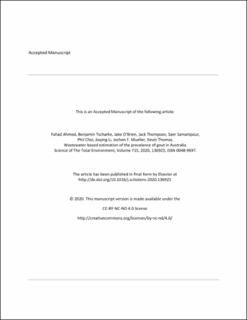| dc.contributor.author | Ahmed, Fahad | |
| dc.contributor.author | Tscharke, Benjamin | |
| dc.contributor.author | O'Brien, Jake | |
| dc.contributor.author | Thompson, Jack | |
| dc.contributor.author | Samanipour, Saer | |
| dc.contributor.author | Choi, Phil | |
| dc.contributor.author | Li, Jiaying | |
| dc.contributor.author | Mueller, Jochen | |
| dc.contributor.author | Thomas, Kevin | |
| dc.date.accessioned | 2020-12-01T09:44:46Z | |
| dc.date.available | 2020-12-01T09:44:46Z | |
| dc.date.created | 2020-09-07T12:10:31Z | |
| dc.date.issued | 2020 | |
| dc.identifier.citation | Science of the Total Environment. 2020, 715. | en_US |
| dc.identifier.issn | 0048-9697 | |
| dc.identifier.uri | https://hdl.handle.net/11250/2711106 | |
| dc.description | Embargo until 25 Jan 2022 | en_US |
| dc.description.abstract | Allopurinol, a first-line gout treatment drug in Australia, was assessed as a wastewater-based epidemiology biomarker of gout via quantification of the urinary metabolite, oxypurinol in wastewater. The in-sewer stability of oxypurinol was examined using laboratory-scale sewer reactors. Wastewater from 75 wastewater treatment plants across Australia, covering approximately 52% (12.2 million) of the country's population, was collected on the 2016 census day. Oxypurinol was quantified in the wastewater samples and population-weighted mass loads calculated. Pearson and Spearman rank-order correlations were applied to investigate any link between allopurinol, other selected wastewater biomarkers, and socio-economic indicators. Oxypurinol was shown to be stable in sewer conditions and suitable as a WBE biomarker. Oxypurinol was detected in all wastewater samples. The estimated consumption of allopurinol ranged from 1.9 to 32 g/day/1000 people equating to 4.8 to 80 DDD/day/1000 people. The prevalence of gout across all tested sewer catchments was between 0.5% to 8%, with a median of 2.9% nationally. No significant positive correlation was observed between allopurinol consumption and alcohol consumption, mean age of catchment population, remoteness or higher socioeconomic status. There was a significant positive correlation with selective analgesic drug use. Wastewater analysis can be used to study gout prevalence and can provide additional insights on population level risk factors when triangulated with other biomarkers. | en_US |
| dc.language.iso | eng | en_US |
| dc.publisher | Elsevier | en_US |
| dc.rights | Attribution-NonCommercial-NoDerivatives 4.0 Internasjonal | * |
| dc.rights.uri | http://creativecommons.org/licenses/by-nc-nd/4.0/deed.no | * |
| dc.title | Wastewater-based estimation of the prevalence of gout in Australia | en_US |
| dc.type | Peer reviewed | en_US |
| dc.type | Journal article | en_US |
| dc.description.version | acceptedVersion | en_US |
| dc.source.pagenumber | 9 | en_US |
| dc.source.volume | 715 | en_US |
| dc.source.journal | Science of the Total Environment | en_US |
| dc.identifier.doi | 10.1016/j.scitotenv.2020.136925 | |
| dc.identifier.cristin | 1827725 | |
| dc.source.articlenumber | 136925 | en_US |
| cristin.ispublished | true | |
| cristin.fulltext | postprint | |
| cristin.fulltext | postprint | |
| cristin.qualitycode | 2 | |

